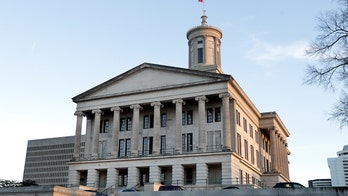
From left, Ohio House of Representatives Speaker Cliff Rosenberger, House Speaker Paul Ryan of Wis., House Minority Leader Nancy Pelosi of Calif., and Senate Majority Leader Mitch McConnell of Ky., applaud during the unveiling of the statue of Thomas Edison in Statuary Hall on Capitol Hill in Washington, Wednesday, Sept. 21, 2016. (AP Photo/Manuel Balce Ceneta)
The elephant in the room, is, well, in this case, the elephant in the room.
The room in question is National Statuary Hall, the old House chamber in the U.S. Capitol. The elephant is a dead circus pachyderm named Topsy. And the question centers on a loose connection between Topsy and the latest addition to the Capitol’s statuary collection: Thomas Alva Edison.
Known as the “The Wizard of Menlo Park,” historians credit Edison with developing the light bulb, the phonograph, the stock ticker and a camera to shoot movies. His prolific inventions earned Edison nearly 1,100 U.S. patents. And in a ceremony this week, congressional leaders dedicated the new Edison statue, representing Ohio.
“When I heard we were unveiling a statue of Thomas Edison, my first thought was ‘We don’t have one already?’” House Speaker Paul Ryan, R-Wis., said at the statue convocation.
Although Edison is closely associated with New Jersey, he was a native of Milan, Ohio. Congress permits each state to send two statues each to Capitol Hill. After years of debate, Ohio elected to scrap the statute of obscure Ohio Gov. William Allen (a vocal critic of Abraham Lincoln) in favor of someone else. Compared to other notable Ohioans, history simply bypassed Allen.
Ohio considered a robust catalogue of luminaries for representation at the capitol. During his remarks at the ceremony, Sen. Rob Portman, R-Ohio, mentioned “Neil Armstrong and 23 other astronauts.” He discussed Ohio’s eight presidents -- though a statue of President James Garfield already graces the Capitol Rotunda.
“We also had a couple of guys named Orville and Wilbur who were in the running,” Portman said. “So this was not easy.”
Ohio also considered Harriet Beecher Stowe. Jesse Owens. Even Barberton, Ohio native Bo Schembechler who became the legendary University of Michigan football coach.
Ahem.
Did someone really think they could hornswoggle Ohio into letting the University of Michigan football coach represent the Buckeye State in the U.S. Capitol for time immemorial?
“We’re a state with a lot to be proud of. But I think we got it right,” said Portman of Ohio settling on Edison.
In the statue, Edison stands tall, proudly hoisting in his right hand toward the sky what is thought to be his most prominent invention: the incandescent light bulb.
More than 20 inventors engineered versions of incandescent lamps prior to Edison. But Edison perfected the bulb and coupled the idea of a singular lamp to a system of lighting an entire room or street.
Of course, a matrix of lamps requires power. Historians believe Edison rose above his rivals by connecting the incandescent bulb with the development of mass power generation and distribution systems.
This brings us to what is known as the “War of Currents.”
A race ensued in the late 19th Century between Edison, George Westinghouse and Nikola Tesla to electrify the world.
Tesla crafted something called an “induction motor,” which helped boost the use of alternating current (AC.) But Edison preferred direct current (DC.)
In 1885, Tesla came to work for Edison with the opportunity to redesign his direct current generators.
Tesla says Edison offered him “$50,000” for the gig, though Edison didn’t have that sort of cash. Tesla completed the task, and Edison never coughed up the $50,000. Edison offered Tesla a significant raise, telling him “you don’t understand our American humor.”
Tesla quit on the spot and went back to perfecting his alternating current system.
Edison saw the advantages of alternating current power but was reluctant to switch. It was expensive. Plus, Edison didn’t want to torpedo his DC work and lose out to Westinghouse and Tesla.
So what do you do if you’re working with Edison? Demonstrate that AC isn’t safe.
Edison’s team tried to taint AC and its development by Tesla to reveal its dangers.
Edison loyalists helped supply New York an electric chair system that ran on AC. Edison opposed capital punishment himself. But by making sure the device used Westinghouse generators, Edison thought he might scare people into never wanting AC brought into their home or business if it was used in the first execution via electric chair.
News reports characterized the exercise as grotesque. Reporters described horrific stenches, burning bone and singed flesh.
“They would have done better using an ax,” declared Westinghouse of the gruesome affair.
In other words, Edison’s team played Westinghouse and Tesla. Edison’s aides managed to orchestrate a well-publicized event to sully the reputations of his rivals and turn the public against the use of AC.
This is where Topsy the elephant comes in.
Topsy was a performer in the Forepaugh Circus and wound up at Coney Island in New York in 1903. There was a plan to execute Topsy for a variety of violent incidents. Edison’s movie cameras were on hand to film Topsy’s execution in another highly-publicized episode to demonstrate the problems with AC.
Edison didn’t appear at Topsy’s execution. And there’s nothing that directly links Edison to the film company or the power industry at that point. But news accounts of the time said Topsy was electrocuted “by electricians of the Edison Power Company.”
The film was also credited on screen to “Thomas A. Edison.”
But it didn’t matter. Alternating current killed Topsy. And if AC is really so powerful to fell an elephant, shouldn’t people consider something else like direct current?
The 74-second “Electrocuting an Elephant” was one of the first films available for the public to watch on Edison’s kinetescopes, a device he crafted to show the earliest movies.
Edison may have a statue in the U.S. Capitol today. But since the mid-1950s, power companies distribute most electricity via alternating current rather than Edison’s direct current.
But who do we think of when it comes to power? Edison, not Tesla. After all, the power company in the New York region is known as ConEdison, not ConTesla.
The brand “Westinghouse” certainly remains in the vernacular of the American consumer. But there’s no statue of George Westinghouse at the U.S. Capitol. And there certainly isn’t a statue of Nikola Tesla on Capitol Hill, either.
Edison clearly possessed better marketing. Despite Edison’s minimal involvement, PR disasters for alternating current with the electric chair and Topsy helped propel his electricity inventions to the forefront at the time, leaving rivals behind.
The Sacramento-based, 1980s hair band “Tesla” indirectly helped propel Nikola Tesla back into the public consciousness as it opened for acts like David Lee Roth and Def Leppard. Elon Musk’s “Tesla Motors” didn’t hurt either. However, in a bizarre twist, it was Edison who invented the first electric car battery. Tesla is virtually synonymous today with electric vehicles.
The focal point of the Capitol’s Edison statue is unquestionably the incandescent light bulb he thrusts above his head. The light bulb is symbolic. It’s as if to say Edison’s gotten another idea. Come up with a new invention. Developed a new device.
The statute by artist Alan Cottrill virtually declares “Let there be light!”
The light of ideas, invention and progress.
Of course the bulb Edison’s statue wields is an incandescent one -- like the ones he perfected.
But in 2007, Congress passed a law mandating the phase-out of incandescent light bulbs in favor of fluorescent ones. Brazil, the European Union, Canada and a host of other countries also voted to ban incandescent bulbs, too.
And who developed the first practical fluorescent bulb? Nikola Tesla.




